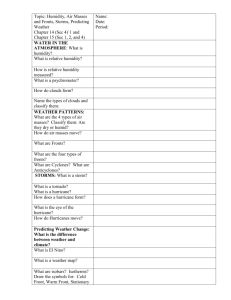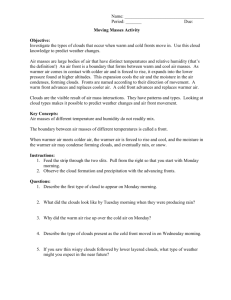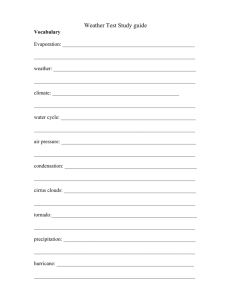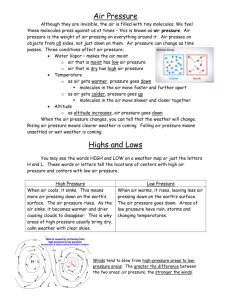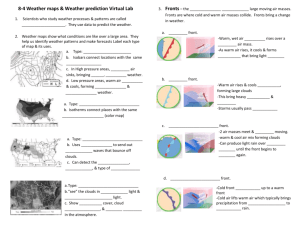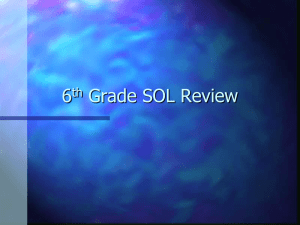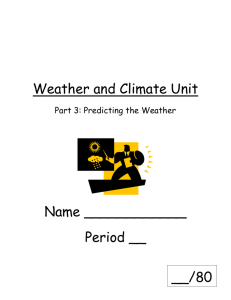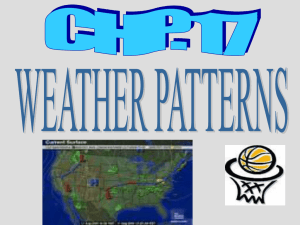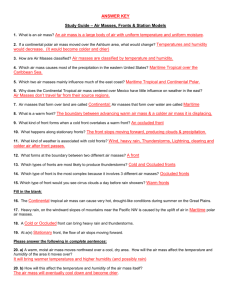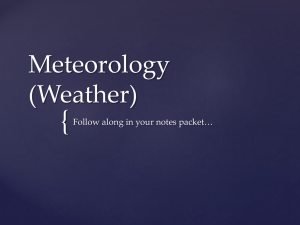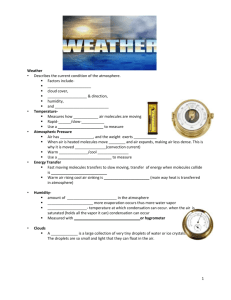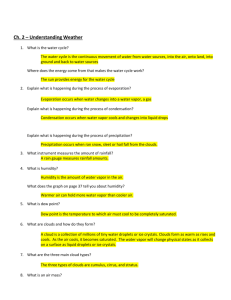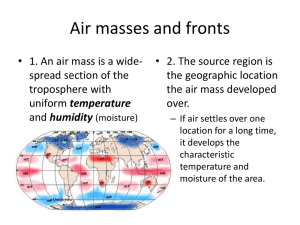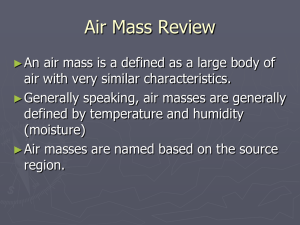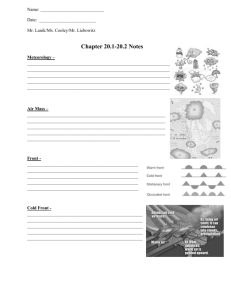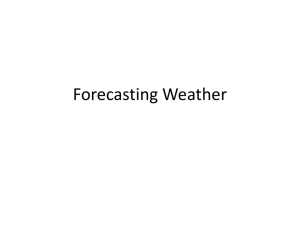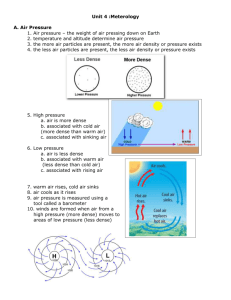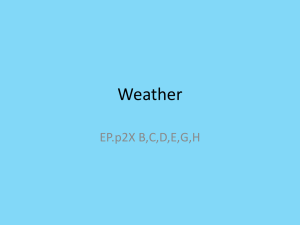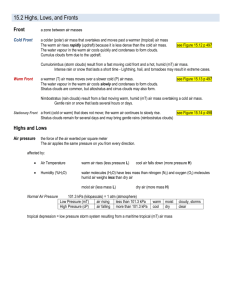Introduction
advertisement
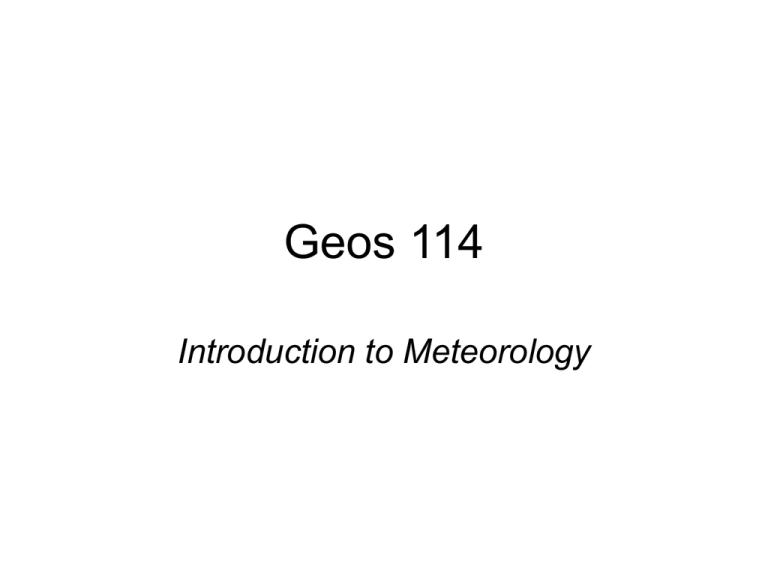
Geos 114 Introduction to Meteorology Definitions • Meteorology – Study of the atmosphere & the processes that causes weather • Weather – State of the atmosphere at a particular place & time. Described by T, Humidity, Ppt., Wind speed • Climate – Average values of weather conditions at some place for at least 30 years beginning with the first year of a decade (i.e. 1971-2000; average annual and monthly temp, ppt). Tabulation of extreme events during time of record i.e. high/low T, greatests snowfall, most intense rainfall) • Climatology – Study of climate, control, spatial and temporal variability Climatic Zones • Tropic Humid (A) • Dry Climates (B) – Steppe (BS) and desert (BW) • Subtropical Climates (C)- Mediterranean • Snow Forest Climates (D)- temperate continental (i.e. northeast US) • Polar Climates (E)- poleward of arctic & antarctic circles • Highland Climates (H)- mountanous terrain every 300 meters of altitude is equivalent to 500km of latitude. Climatic Zones Sources of Weather Info • Weather Radio – Low Power VHF High Band FM – Constant weather information – Repeat messages every 4-6 minutes – Transmits all other sorts of emergencies • Cable & Broadcast TV – The Weather Channel • WWW NOAA Weather Radio The Weather Channel Intro to Weather Systems & Maps • ASOS: Automated Surface Observing System (installed at airports) records 24hrs/day – Temp., humidity, dew point, wind speed & direction, Pressure ASOS Pressure Systems • Pressure: weight per unit area of a column of air stretching from the earth’s surface up to through the atmosphere • Highs (anticyclones) – – – – – ‘H’ on a map Fair weather systems Cold or cool, dry air (NW Canada) Hot, mild, dry air (from land further south) Clockwise, outward spiral • Lows (cyclones) – ‘L’ on a map – Stormy weather systems – Counterclockwise, inward spiral • Highs and lows move with prevailing winds (eastward in North America) Pressure Systems H L Air Masses • Large uniform air mass (temperature and humidity) associated with high pressure system • Cold air masses form at high latitudes • Humid air masses over maritime surfaces • Dry air masses over arid/semi arid regions • Cold & Dry • Cold & Humid • Warm & Dry • Warm & Humid Fronts • Narrow band between 2 air masses that differ in T, humidity, or both • Fronts form where air masses collide – Ppt & cloudiness • Fronts: – Stationary – Cold – Warm Fronts Fronts Vocabulary • • • • • • • • • • Max. T (oF; oC) Min. T Dew Point Relative Humidity (%) Ppt. amount Air pressure (29.92 inches, 760 millimeters Hg; millibars (mb) 1013.25mb at sea level) Wind direction; speed Sky cover (no clouds; few (1/8-2/8 cloud cover); scattered (3/8-4/8); broken clouds (5/8-7/8); overcast (completely cloud covered)) Weather watch- NWS possibility of hazard Weather warning- NWS imminent hazard Weather Satellites • GOES (geostationary operational environmental satellite) – 36,000km (22,300mi); equatorial, eastward motion, same view 75oW, 135oW • POES (polar-orbiting operational environmental satellite) – N-S orbit 800-1000km above surface • Measure visible radiation that is scattered or reflected and infrared GOES Weather Radar & Doppler • Complements satellite data • Microwave radiation • Emits pulses that are reflected by rain, snow, hail which appear as blotches known as echoes • Doppler determines velocity of targets moving towards or away from unit depending on frequency bet. Outgoing & returning signal • Monitor circulation of air within a storm system and provide advance warning of severe weather Doppler Radar Sky Watching • Clouds- aggregates of water droplets or ice crystals or both • Fog- ground contact cloud reduces visibility to less than 1000m • Stratiform- horizontal layers, gentle rising of air over broad region ahead of a warm front • Cumuliform- puffy, vigorous ascent of warm air ahead of a cold front Clouds • Fair weather cumulus clouds • Storm cumulonimbus clouds produce lightning & thunder • Clouds at different altitudes may move horizontally in different directions and speeds Cloud Types
